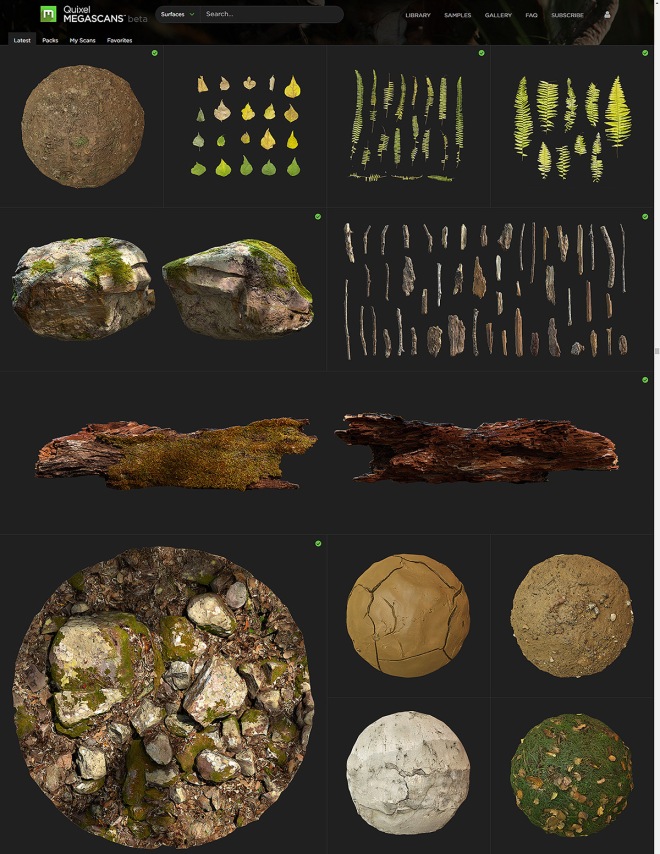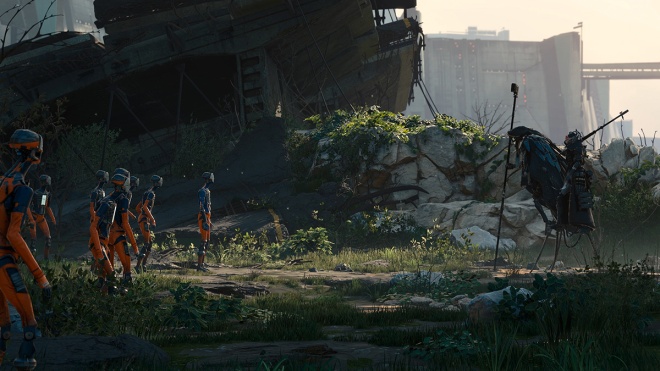OK, what is this Megascans thing?
Posted in: Animation
A few months ago I started hearing about Swedish company Quixel’s Megascans and that it had been used by MPC on The Jungle Book for some of the intricate plant and jungle life textures on that film. But it was still unclear exactly what Megascans, a material library based on real-life scans of mostly vegetation and other organic surfaces, ‘was’. So at SIGGRAPH I asked Quixel founder Teddy Bergsman. Overnight, Megascans has just been launched in public beta, which seemed like a good time to run this interview – hope you enjoy!
vfxblog: Where did Megascans come from as an idea? What were its origins?
Teddy Bergsman: The origins of Megascans stems from the need for a modern and vast library of high quality source materials. Artists need to spend a lot of time just to get a basic palette of materials done, either painting, sculpting, photo sourcing, custom scanning/processing or procedurally generating. By being able to rely on a realistic, high quality, standardized and physically based library of scanned assets, in conjunction with highly streamlined production tools to fully customize and integrate the scans, many head aches go away. The artistic experience gets to be more about having fun and playing around with broader creative ideas, rather than cleaning photos or raw scan data, or spending much of the time programming complex procedural node networks.
My professional background is in system engineering, texturing and scanning, having developed a number of scanning and processing systems since 2006 primarily for the AAA games industry. The idea behind Megascans as a massive online library of standardized scans formed in early 2011. As for the technology, I wanted to develop a portable scanner that could withstand extreme climates, to be used in remote locations for capturing both reflectance and geometrical properties of large interesting surfaces, in an automatic manner during any time of day.

The idea was then to fully capture these environments in a fully standardized way and to categorize and publish the data on a modern and easily searchable online platform. To afford building the hardware, software, scans and all online and desktop services, I aimed to write a number of art tools (later to be named NDO, DDO and 3DO in various iterations) for the games and film industries, and these have luckily helped us stay afloat, thanks to a wonderful community of artists and studios. Fast forward five years, and you have Megascans!
vfxblog: Can you explain exactly what the concept is and what it delivers?
Teddy Bergsman: Megascans is a massive online scan library, covering tens of thousands of scanned specimens including surfaces, vegetation and objects, fully standardized and physically based. It comes as a subscription service, and also includes a brand new line of production tools for mixing surface scans and exporting scans directly to major renderers and engines.
The service is fast growing, with over a hundred new scans being added every week. Everything is scanned and organized according to a comprehensive ecosystem philosophy, covering every specimen of any given biome. Artists can also get these full ecosystems as off the shelf curated packs, as an alternative or complement to the subscription.

vfxblog: What R&D was required to make it possible?
Teddy Bergsman: Megascans is the result of just over a decade of R&D, originally just myself and later together with an engineering team to help advance all hardware aspects. The most important aspect has been automation and ensuring minimal manual input when processing the scans. The scanners and processing pipelines used for creating Megascans are completely custom built, and allow for scaling the library very quickly due to a high degree of mechanical and programmatic automation.
We have been lucky to get the data production proofed by many major studios during the course of the alpha and beta and feel excited to be able to hand the library off in a state that plugs right into any modern physically based pipelines.

R&D is always ongoing and we are constantly on the look out for how to improve our scanning and processing workflows. During the course of development we have built around a dozen machines all with pertaining data compilation software, each machine covering a specific type of scanning. With the rapid world-wide adaptation of physically based rendering, the processing pipelines have also undergone a number of major transformations over the past few years, which has had huge (but important) implications when dealing with petabytes of data to be reprocessed.
vfxblog: How was it used on Jungle Book? How did you work with MPC to deliver the scans/assets and what things were improved upon or changed during and as a result?
Teddy Bergsman: In early 2105 MPC Film reached out to us regarding a number of fully scanned jungle environments that we had recently showcased. These biomes seemed to fit their needs well, and so MPC acquired online alpha access to our South East Asian vegetation scan library, as well as accompanying soil surfaces from the same area.
This was an excellent opportunity for us to get additional production proofing, and MPC were very easy to work with as they quickly integrated the library in their production pipeline without needing our support.

Worth noting is that we have continued to improve on our processing pipelines since this collaboration. Every scan that was used for The Jungle Book is thus available in the Megascans library at a higher fidelity than was available at the time of making the film.
Learning how useful the vegetation scans were in particular, we have since increased the size of the vegetation library substantially, now also scanning vegetation full-time in Oceania and the Nordic.

vfxblog: What is the future of Megascans? Is it still considered a ‘secret’ thing? How might people or studios access it?
Teddy Bergsman: The Megascans library is incredibly close to a public release. It has been in private beta for just over a year, and has been integrated in many large productions already during this time. We have typically granted early access to studios who have reached out to us directly with needs that are fully accommodated by the service.
Most aspects of the service have been kept secret, as we want to surprise our customers with something that is fresh and exciting. We have many things planned for the future of Megascans, for many years to come. This includes not only more biomes and material categories, but also new scan data types, accompanying software tools, external app integrations and many new site features, on top of a rapidly growing library.

Studios and individual artists will be able to access Megascans shortly as we are launching the open beta next, unlocking a large subset of the natural scan categories of the library. The library and tools are made available as a simple subscription service, and you may also download entire ecosystems separately, curated from the library.
My personal goal has always been to make Megascans a very affordable and accessible service to artists, as I’ve been a strong believer in and long time promoter of scan data and how it can greatly facilitate computer graphics production. This has been a decade long ambition for me, and the texturing tools that we released have all revolved around using scan based data. It’s incredibly inspiring to me to see that scanning is now catching on big time.

Equally challenging to building the scanners and library for us has been to build a high performing and scalable online backend for serving the scans in a simple, standardized and customizable manner. We’re finally there and feel excited to open it up and keep expanding on this system with a constant stream of new data for people to enjoy and have fun with. As an artist I’m even more excited to see all the art from the fantastic community we are lucky to be part of.
More info at https://megascans.se/

Post a Comment